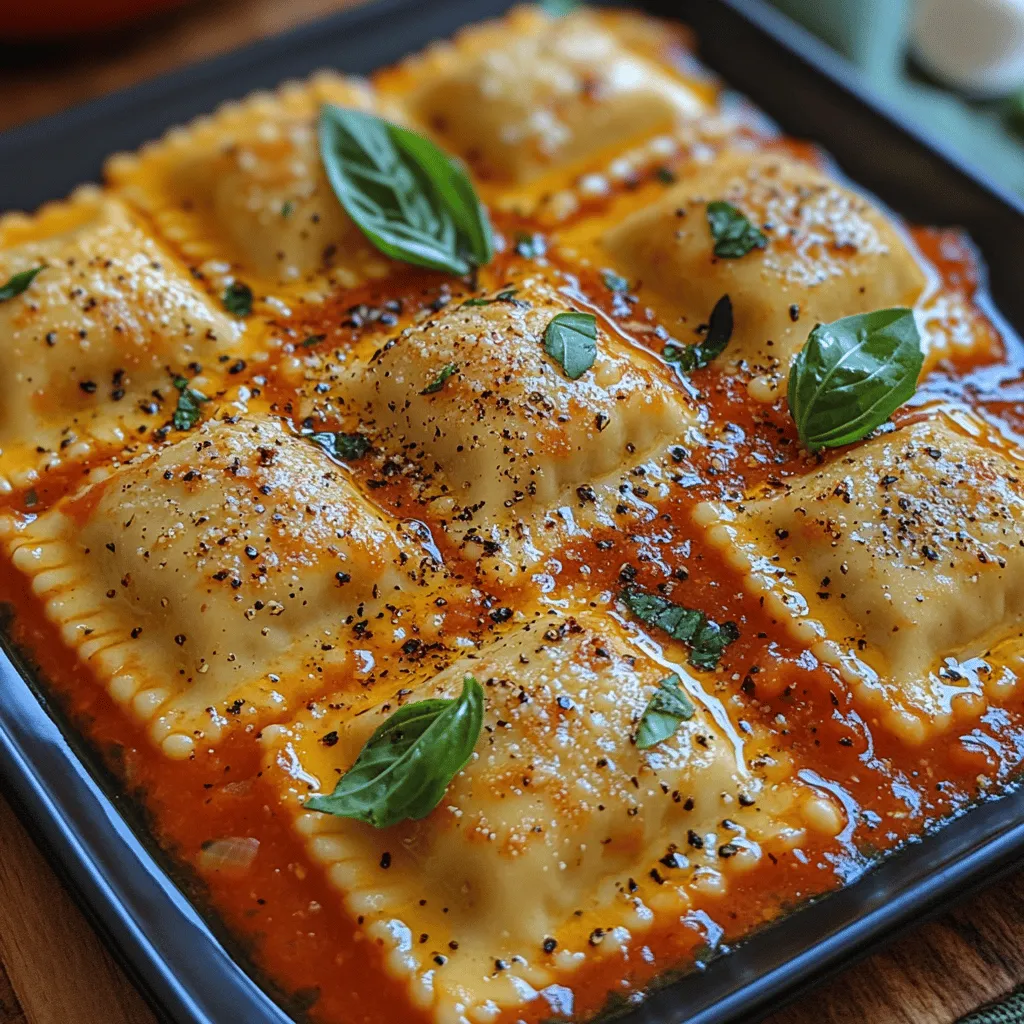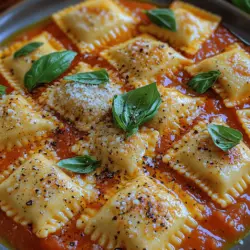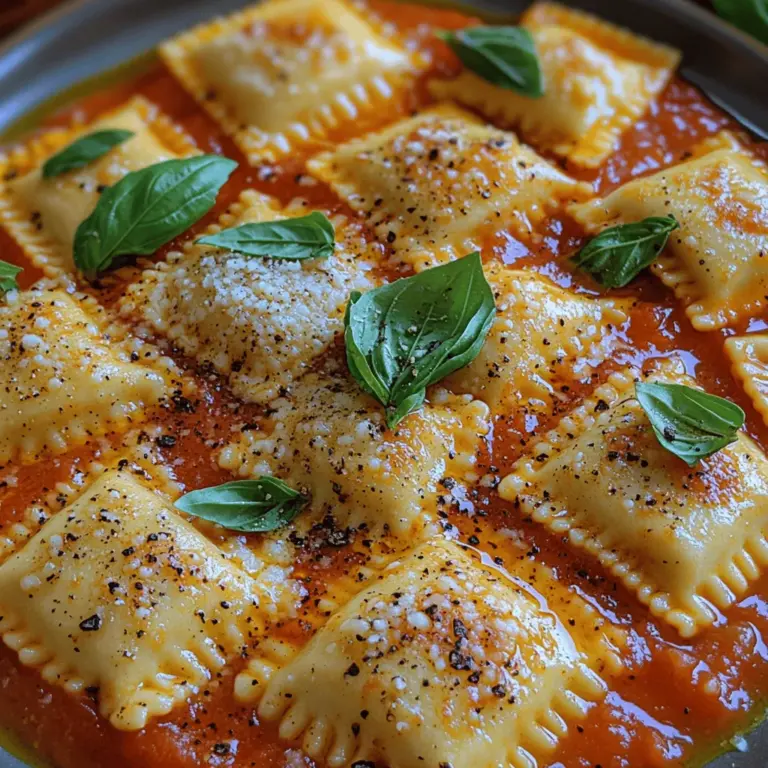Ravioli al Pomodoro e Aglio is a beloved dish that embodies the essence of Italian comfort food. This delightful pasta dish features fresh ravioli enveloped in a rich and flavorful tomato-garlic sauce, creating a harmonious blend of taste and texture that transports you to the heart of Italy with every bite. Renowned for its simplicity yet profound flavors, Ravioli al Pomodoro e Aglio highlights the importance of using fresh, high-quality ingredients, a hallmark of traditional Italian cooking.
Italian cuisine is celebrated worldwide for its commitment to freshness and authenticity. When preparing Ravioli al Pomodoro e Aglio, the quality of each ingredient significantly influences the final dish. This recipe allows the natural flavors of the tomatoes, garlic, and olive oil to shine through, creating a meal that is both satisfying and uncomplicated. The beauty of Italian cooking lies in its ability to transform simple ingredients into extraordinary dishes, and this ravioli recipe is a perfect example of that culinary philosophy.
Ravioli, a type of pasta that consists of stuffed dough, has captured the hearts of food lovers across the globe. Its versatility allows for endless variations in fillings and sauces, making it a favorite in various cuisines. From classic cheese fillings to adventurous combinations like pumpkin or wild mushrooms, ravioli can cater to a wide range of taste preferences. Whether served in a rich meat sauce, a light broth, or, as in this recipe, a vibrant tomato-garlic sauce, ravioli remains a timeless option for any meal occasion.
Understanding Ravioli
To fully appreciate Ravioli al Pomodoro e Aglio, it’s essential to delve into the history and cultural significance of ravioli in Italian cuisine. Originating from the Lombardy region of Italy, ravioli can be traced back to the Middle Ages, with early references appearing in cookbooks from the 14th century. Traditionally, ravioli were made by hand, with families passing down their unique recipes through generations. This artisanal approach to pasta-making has contributed to ravioli’s esteemed status in Italian culinary tradition.
There are numerous types of ravioli, each showcasing the region’s distinct flavors and ingredients. While cheese-filled ravioli, such as ricotta and spinach, may be the most well-known, other fillings range from seasonal vegetables to rich meats and seafood. The versatility of ravioli makes it a popular choice for various occasions, from celebratory feasts to everyday meals. It is often served as a first course (primo) in Italian dining, highlighting its importance in the overall dining experience.
In Italy, ravioli is not merely a meal but a symbol of family and tradition. Preparing ravioli often becomes a communal activity, bringing people together to share laughter, stories, and culinary skills. The act of making ravioli, whether from scratch or using store-bought options, fosters a sense of connection and appreciation for the craft of cooking.
Ingredient Breakdown
Fresh vs. Frozen Ravioli
When it comes to choosing ravioli for your dish, you may find yourself at a crossroads: fresh or frozen? Both options have their merits, so let’s explore their advantages and considerations.
Fresh ravioli is typically made from scratch or purchased from local pasta shops, offering a tender texture and robust flavor. The delicate pasta dough allows for a more authentic taste experience, making it ideal for special occasions or when you want to impress guests. However, fresh ravioli has a short shelf life and should be used within a few days of purchase.
On the other hand, frozen ravioli provides convenience without sacrificing too much quality. Often pre-cooked and flash-frozen, these ravioli can be easily stored and prepared at a moment’s notice. While they may not have the same level of flavor as fresh ravioli, choosing high-quality frozen options can yield satisfactory results. Ultimately, the choice between fresh and frozen ravioli depends on your personal preference and how much time you have to dedicate to the dish.
Olive Oil
In Italian cooking, olive oil is not just an ingredient; it is the backbone of flavor and a staple in countless recipes. When preparing Ravioli al Pomodoro e Aglio, the quality of olive oil can make a significant difference in the overall taste of the dish. Opt for extra virgin olive oil, as it is the highest quality available and boasts a rich, fruity flavor profile.
Beyond enhancing flavor, olive oil also provides health benefits, including heart-healthy fats and antioxidants. Its versatility makes it suitable for drizzling, sautéing, or even as a finishing touch on the dish. When selecting olive oil, consider the region from which it originates, as different areas produce oils with unique flavor notes.
Garlic and Onion
The aromatic foundations of the sauce in Ravioli al Pomodoro e Aglio are built on two essential ingredients: garlic and onion. Garlic, with its robust flavor and numerous health benefits, is a key player in this dish. It adds depth and richness to the sauce, ensuring that each bite is bursting with flavor. Fresh garlic is preferred for its intense aroma and taste, but if you don’t have access to fresh, high-quality garlic powder can be used as a substitute.
Onions, often sautéed alongside garlic, contribute a natural sweetness that balances the acidity of the tomatoes. The combination of these two aromatics creates a fragrant base that elevates the dish to a new level. When preparing the sauce, be mindful of cooking the garlic until lightly golden, as overcooking can lead to a bitter taste.
Diced Tomatoes
The star of the sauce in Ravioli al Pomodoro e Aglio is, without a doubt, the diced tomatoes. The importance of freshness and variety cannot be overstated; using high-quality tomatoes will significantly enhance the overall flavor of the dish. For an authentic taste, consider using San Marzano tomatoes, a variety renowned for its sweet and rich flavor. These tomatoes are often considered the gold standard in Italian cooking due to their low acidity and meaty texture.
When selecting tomatoes, you can choose between canned or fresh options. Canned tomatoes are a convenient choice and can deliver consistent results year-round, while fresh tomatoes can offer a vibrant taste during peak seasons. Regardless of your choice, ensure that the tomatoes are ripe and flavorful to create a sauce that complements the ravioli perfectly.
Spices and Seasonings
To bring the sauce to life, a blend of spices and seasonings is essential. Common additions include oregano, sugar, salt, pepper, and fresh basil. Oregano adds an earthy note and is a classic Italian herb, while a pinch of sugar can balance the acidity of the tomatoes, creating a well-rounded flavor profile. Salt and pepper are fundamental seasonings that enhance all ingredients, while fresh basil adds a pop of color and a fragrant aroma to the dish.
Experimenting with these spices will allow you to tailor the flavors to your liking. For those who enjoy a bit of heat, consider adding a pinch of red pepper flakes to elevate the dish with a spicy kick.
Parmesan Cheese
No Italian dish is complete without a sprinkle of cheese, and Ravioli al Pomodoro e Aglio is no exception. Parmesan cheese adds a savory depth and creamy texture to the dish. When choosing parmesan, opt for Parmigiano-Reggiano, the authentic Italian cheese known for its sharp, nutty flavor. Freshly grated parmesan will melt beautifully over the hot ravioli, creating a delectable finish to the meal.
When purchasing parmesan, look for wheels or blocks rather than pre-grated options, as the latter often contain additives that can compromise flavor. Investing in high-quality cheese will elevate your dish and provide an authentic Italian experience.
Optional Ingredients
In addition to the primary ingredients, there are optional additions that can enhance the flavor of Ravioli al Pomodoro e Aglio. For those who enjoy a little heat, red pepper flakes can be a fantastic way to spice up the dish. Simply sprinkle a small amount into the sauce while it simmers to achieve your desired level of spiciness.
Another optional ingredient is fresh herbs, such as parsley or thyme, which can be added to the sauce or used as a garnish. These fresh herbs will provide a burst of color and flavor, making your dish not only delicious but visually appealing as well.
Preparing the Dish
Now that we have a solid understanding of the ingredients and their significance in Ravioli al Pomodoro e Aglio, it’s time to dive into the preparation of this delightful dish.
Step 1: Cook the Ravioli
Begin by bringing a large pot of salted water to a rolling boil. The salt is crucial for infusing flavor into the pasta as it cooks. Once the water is boiling, carefully add the ravioli, ensuring they have enough space to move freely. Fresh ravioli typically cooks in 3 to 5 minutes, while frozen ravioli may require a few extra minutes. Follow the package instructions for cooking times to achieve the perfect texture.
To test for doneness, sample a ravioli; it should be tender yet firm to the bite, also known as “al dente.” Once cooked, drain the ravioli in a colander, ensuring to reserve a cup of the starchy pasta water, which can be useful for adjusting the sauce’s consistency later.
Step 2: Prepare the Sauce
While the ravioli is cooking, you can start preparing the sauce. In a large skillet, heat a generous drizzle of extra virgin olive oil over medium heat. Add finely chopped onions and sauté until they become translucent, about 3 to 4 minutes. Next, add minced garlic and continue to sauté for an additional minute, being careful not to let it burn.
Once the onions and garlic are aromatic, pour in the diced tomatoes, including their juices. Stir to combine, and let the sauce simmer for about 10 to 15 minutes, allowing the flavors to meld and the sauce to thicken slightly.
As the sauce simmers, season with oregano, sugar, salt, and pepper to taste. If you’ve chosen to add red pepper flakes, this is the time to include them as well.
Step 3: Combine Ravioli and Sauce
After the sauce has reached your desired consistency, gently add the cooked ravioli to the skillet. Using a spatula, carefully toss the ravioli in the sauce, ensuring they are evenly coated. If the sauce seems too thick, add a splash of the reserved pasta water to loosen it up and create a silky texture.
Let the ravioli and sauce heat together for an additional minute, allowing the flavors to meld even further. Finally, remove the skillet from heat and stir in a handful of freshly chopped basil for a burst of freshness.
This detailed preparation process not only ensures that your Ravioli al Pomodoro e Aglio is delicious but also highlights the beauty of cooking with quality ingredients and traditional techniques. As you embark on this culinary journey, you’ll find that the effort put into each step yields a dish that is not only satisfying but also deeply rewarding.

Crafting the Tomato-Garlic Sauce
The tomato-garlic sauce is the heart of the Ravioli al Pomodoro e Aglio, providing a rich, flavorful base that elevates this dish. Crafting it requires attention to detail, particularly when it comes to sautéing garlic and simmering the sauce.
Techniques for Sautéing Without Burning Garlic
Garlic is a foundational flavor in many Italian dishes, but it can easily go from fragrant to bitter if overheated. To sauté garlic without burning it, start by using a medium heat setting. Heat your olive oil in a pan until it’s warm but not smoking. Once the oil is hot, add minced garlic and stir frequently. Look for a light golden color, which indicates that the garlic is just right. If you notice it browning too quickly, reduce the heat immediately and add a splash of water or a few tomatoes to cool it down.
The Simmering Process: Why It Matters for Flavor Development
After sautéing the garlic, it’s time to add your crushed tomatoes. Allow the mixture to come to a gentle simmer, which is crucial for flavor development. Simmering enables the ingredients to meld together, enhancing the overall taste. Allow the sauce to simmer for at least 15-20 minutes. This duration allows the acidity of the tomatoes to mellow and the flavors to concentrate. Stir occasionally to prevent sticking and ensure an even cook. For added depth, you can incorporate a pinch of sugar to balance the acidity, along with fresh basil or oregano for a fragrant finish.
Tips for Combining Ravioli and Sauce: Ensuring Even Coating Without Breaking the Pasta
Once your ravioli is cooked and your sauce is ready, it’s time for the crucial step of combining the two. To ensure that the ravioli are coated evenly without breaking, follow these steps:
1. Gentle Drain: After boiling your ravioli, use a slotted spoon to transfer them directly to the sauce. This method helps retain some of the pasta water, which can aid in sauce adherence.
2. Toss Gently: In the pan, gently toss the ravioli with the sauce using a spatula. Avoid stirring too vigorously as this can cause the delicate pasta to break apart. Instead, lift the ravioli from the bottom and fold them over the sauce.
3. Add Pasta Water: If the sauce is too thick, add a tablespoon or two of the reserved pasta water. This starchy water helps the sauce cling better to the ravioli while also enhancing creaminess.
Serving Suggestions
Now that your Ravioli al Pomodoro e Aglio is beautifully plated, consider how to elevate your dining experience with thoughtful presentation and complementary sides.
Presentation Ideas for a Beautiful Plate of Ravioli al Pomodoro e Aglio
For an eye-catching presentation, use a large, shallow bowl to serve your ravioli. Place the ravioli in the center and spoon sauce generously over the top. Finish with a sprinkle of freshly grated Parmesan cheese and a few basil leaves for a pop of color. Drizzling a bit of high-quality extra virgin olive oil over the dish can also add a glossy finish and enhance the flavor.
Pairing with Sides: Suggestions for Salads or Bread that Complement the Dish
To round out your meal, consider pairing Ravioli al Pomodoro e Aglio with a light, refreshing salad. A simple arugula salad dressed with lemon vinaigrette can provide a nice contrast to the richness of the ravioli. Alternatively, a classic Caprese salad with fresh mozzarella, tomatoes, and basil would harmonize beautifully.
Don’t forget about bread! A crusty Italian ciabatta or focaccia is perfect for soaking up the delicious sauce. You could also serve garlic bread for an extra touch of flavor.
Wine Pairing Recommendations: Ideal Choices for Enhancing the Dining Experience
When it comes to wine pairings, a light-bodied red like Chianti or a white wine such as Pinot Grigio can complement the flavors of the dish nicely. Chianti, with its bright acidity and cherry notes, works well with the tomato sauce, while Pinot Grigio offers a crisp, refreshing contrast.
Nutritional Analysis
Understanding the nutritional content of your dish can help you enjoy it more mindfully. Here’s a breakdown of the nutritional content per serving of Ravioli al Pomodoro e Aglio:
– Calories: Approximately 350-400 calories, depending on the quantity and ingredient specifics.
– Fats: Around 10-15 grams, largely from the olive oil and cheese.
– Carbohydrates: Roughly 50-60 grams, primarily from the pasta and tomatoes.
– Proteins: About 12-15 grams, mainly from the ravioli filling and Parmesan cheese.
Discussion on the Health Benefits of the Primary Ingredients
The main ingredients in this dish offer numerous health benefits. Tomatoes are rich in antioxidants, particularly lycopene, which is known for its heart-health benefits. Garlic is celebrated for its potential to lower blood pressure and improve cholesterol levels. Olive oil, a staple in Mediterranean diets, is packed with healthy fats that can help reduce inflammation.
Ways to Modify the Recipe for Dietary Preferences
If you have dietary preferences or restrictions, this recipe can be easily modified:
– Gluten-Free: Substitute traditional pasta with gluten-free ravioli made from rice or corn flour.
– Vegan Options: Use a plant-based filling for the ravioli and omit the cheese or replace it with a dairy-free alternative.
Culinary Tips and Tricks
To ensure your Ravioli al Pomodoro e Aglio turns out perfectly, keep these tips in mind:
Common Mistakes to Avoid When Making Ravioli and Sauces
1. Overcooking Ravioli: Fresh ravioli cooks quickly, usually within 3-5 minutes. Taste them to ensure they are al dente.
2. Burning Garlic: As mentioned earlier, garlic can easily burn. Keep an eye on it and sauté over moderate heat.
3. Too Thick Sauce: If your sauce is too thick, it can clump on the ravioli. Remember to add reserved pasta water to achieve the right consistency.
Storage Suggestions for Leftovers: Best Practices for Reheating
If you have leftovers, store the ravioli and sauce separately to maintain the quality of the dish. Place them in airtight containers and refrigerate. They will last for up to 3 days. When reheating, do so gently on the stovetop over low heat, adding a splash of water or olive oil to prevent drying out.
How to Customize the Recipe: Adding Proteins, Vegetables, or Alternative Sauces
Feel free to customize your Ravioli al Pomodoro e Aglio. For added protein, consider sautéing shrimp or chicken breast and mixing it in with the sauce. You can also add vegetables like spinach or zucchini for extra nutrition and flavor. If you want to try a different sauce, consider making a creamy Alfredo or a pesto to vary the taste.
Conclusion
Ravioli al Pomodoro e Aglio is a delightful dish that embodies the essence of Italian cuisine—simple yet incredibly flavorful. With its fresh ingredients and straightforward preparation, this recipe invites you to enjoy cooking and sharing delicious meals with loved ones. Whether you stick to the classic recipe or choose to experiment with variations, the joy of making and indulging in homemade ravioli is truly unparalleled. So gather your ingredients, follow these steps, and savor the satisfaction of creating a memorable meal that brings a taste of Italy to your table.

